
 |
 Handbook of Explosion Prevention and Protection By 2004 | 720 Pages | ISBN: 3527307184 | PDF | 6 MB Between them, the renowned team of editors and authors have amassed unparalleled experience at such institutes as BAM, PTB, Pittsburgh National Institute for Occupational Health and Safety, BASF AG, and the University of Göttingen. In this work-the first of its kind for 35 years-they describe in detail those measures that prevent or limit industrial explosions and the damage so caused. They cover various preventative methods, as well as the current state of technology combined with data gained through experimentation. This handbook offers operational, planning, design and safety engineers working in industry, government agencies and professional associations in-depth knowledge of the scientific and technical basics, allowing them to apply explosion protection according to any given situation.Content: Chapter 1 Explosion Processes (pages 1-60): Prof. Dr. H. Gg. WagnerChapter 2 Ignition Processes (pages 61-270): Dr. Helmut Kramer, Dr. Martin Glor, Prof. Dr. Henrikus Steen, Dr. Markus Goedde, Dr. Heino Bothe, Dipl.?Ing. Eberhard Behrend, Dr?Ing. Klaus Ritter, Prof. Dr. H. Gg. Wagner, Dr.?Ing. Willi Hensel, Dr.?Ing. Ulrich Krause, Dr. Ulrich Loffler and Dr. Winfried KarlChapter 3 Properties of Reactive Gases and Vapours (Safety Characteristics) (pages 271-377): Dr. Elisabeth Brandes, Dr. Siegmund Dietlen, Dr. Hartmut Hieronymus, Dr.?Ing. Ulrich Krause, Dr. Bodo Plewinsky, Dr. Tammo Redeker, Dr. Volkmar Schroder and Prof. Dr. Karlheinz HoyermannChapter 4 Properties of Combustible Dusts (Safety Characteristics) (pages 379-417): Dr.?Ing. Willi Hensel and Kenneth L. CashdollarChapter 5 Properties of Flammable Mists and Foams (pages 419-480): Dr. Hans Forster, Dr. Bodo Plewinsky and Dr. Hartmut HieronymusChapter 6 Measures of Explosion Protection and Prevention (pages 481-610): Prof. Dr. Henrikus Steen, Dr. Martin Hattwig, Dr.?Ing. Ulrich Krause, Dr. Christophe Proust, Dipl.?Ing. Richard Siwek, Dr. Hans Forster and Dr. Wolfgang WiechmannChapter 7 Fundamentals of Understanding and Judging Explosion Risks (pages 611-639): Prof. Dr.?Ing. Henrikus Steen 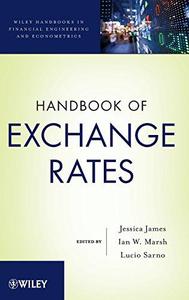 Handbook of Exchange Rates By 2012 | 830 Pages | ISBN: 0470768835 | PDF | 8 MB Praise for Handbook of Exchange Rates"This book is remarkable. I expect it to become the anchor reference for people working in the foreign exchange field."?Richard K. Lyons, Dean and Professor of Finance, Haas School of Business, University of California Berkeley"It is quite easily the most wide ranging treaty of expertise on the forex market I have ever come across. I will be keeping a copy close to my fingertips."?Jim O'Neill, Chairman, Goldman Sachs Asset ManagementHow should we evaluate the forecasting power of models? What are appropriate loss functions for major market participants? Is the exchange rate the only means of adjustment? Handbook of Exchange Rates answers these questions and many more, equipping readers with the relevant concepts and policies for working in today's international economic climate.Featuring contributions written by leading specialists from the global financial arena, this handbook provides a collection of original ideas on foreign exchange (FX) rates in four succinct sections:* Overview introduces the history of the FX market and exchange rate regimes, discussing key instruments in the trading environment as well as macro and micro approaches to FX determination.* Exchange Rate Models and Methods focuses on forecasting exchange rates, featuring methodological contributions on the statistical methods for evaluating forecast performance, parity relationships, fair value models, and flow-based models.* FX Markets and Products outlines active currency management, currency hedging, hedge accounting; high frequency and algorithmic trading in FX; and FX strategy-based products.* FX Markets and Policy explores the current policies in place in global markets and presents a framework for analyzing financial crises.Throughout the book, topics are explored in-depth alongside their founding principles. Each chapter uses real-world examples from the financial industry and concludes with a summary that outlines key points and concepts.Handbook of Exchange Rates is an essential reference for fund managers and investors as well as practitioners and researchers working in finance, banking, business, and econometrics. The book also serves as a valuable supplement for courses on economics, business, and international finance at the upper-undergraduate and graduate levels.Content: Chapter 1 Foreign Exchange Market Structure, Players, and Evolution (pages 1-44): Michael R. King, Carol Osler and Dagfinn RimeChapter 2 Macro Approaches to Foreign Exchange Determination (pages 45-71): Menzie ChinnChapter 3 Micro Approaches to Foreign Exchange Determination (pages 73-110): Martin D. D. Evans and Dagfinn RimeChapter 4 The Exchange Rate in a Behavioral Finance Framework (pages 111-132): Paul De Grauwe and Pablo Rovira KaltwasserChapter 5 The Evolution of Exchange Rate Regimes and Some Future Perspectives (pages 133-158): Paul R. MassonChapter 6 Purchasing Power Parity in Economic History (pages 159-187): Lawrence H. OfficerChapter 7 Purchasing Power Parity in Tradable Goods (pages 189-220): Ian W. Marsh, Evgenia Passari and Lucio SarnoChapter 8 Statistical and Economic Methods for Evaluating Exchange Rate Predictability (pages 221-263): Pasquale Della Corte and Ilias TsiakasChapter 9 When Are Pooled Panel?Data Regression Forecasts of Exchange Rates More Accurate than the Time?Series Regression Forecasts? (pages 265-281): Nelson Mark and Donggyu SulChapter 10 Carry Trades and Risk (pages 283-312): Craig BurnsideChapter 11 Currency Fair Value Models (pages 313-342): Gino Cenedese and Thomas StolperChapter 12 Technical Analysis in the Foreign Exchange Market (pages 343-373): Christopher J. Neely and Paul A. WellerChapter 13 Modeling Exchange Rates with Incomplete Information (pages 375-390): Philippe Bacchetta and Eric van WincoopChapter 14 Exchange Rates in a Stochastic Discount Factor Framework (pages 391-420): Hanno Lustig and Adrien VerdelhanChapter 15 Volatility and Correlation Timing in Active Currency Management (pages 421-447): Pasquale Della Corte, Lucio Sarno and Ilias TsiakasChapter 16 Active Currency Management Part I: Is There a Premium for Currency Investing (Beta) (pages 451-469): Geoffrey Kendrick and Saeed AmenChapter 17 Active Currency Management Part II: Is There Skill or Alpha in Currency Investing? (pages 471-501): Richard M. Levich and Momtchil PojarlievChapter 18 Currency Hedging for International Bond and Equity Investors (pages 503-543): Kristjan KasikovChapter 19 FX Reserve Management (pages 545-561): Michael J. PaulusChapter 20 High Frequency Finance: Using Scaling Laws to Build Trading Models (pages 563-584): Alexandre Dupuis and Richard B. OlsenChapter 21 Algorithmic Execution in Foreign Exchange (pages 585-597): James E. DaltonChapter 22 Foreign Exchange Strategy Based Products (pages 599-621): Aysu SecmenChapter 23 Foreign Exchange Futures, Forwards, and Swaps (pages 623-645): Naohiko Baba, Yuji Sakurai and Frank PackerChapter 24 FX Options and Volatility Derivatives: An Overview from the Buy?Side Perspective (pages 647-696): Oleg SvirschiChapter 25 A Common Framework for Thinking about Currency Crises (pages 697-716): Robert Flood, Nancy Marion and Juan Yepez AlbornozChapter 26 Official Intervention in the Foreign Exchange Market (pages 717-749): Marcel FratzscherChapter 27 Exchange Rate Misalignment-The Case of the Chinese Renminbi (pages 751-765): Yin?Wong CheungChapter 28 Choosing an Exchange Rate Regime (pages 767-784): Jeffrey A. Frankel
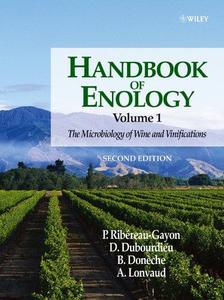 Handbook of Enology: The Microbiology of Wine and Vinifications, Volume 1, 2nd Edition By Professor Pascal Ribereau?Gayon, Denis Dubourdieu, Bernard Doneche, Aline Lonvaud(auth.) 2005 | 497 Pages | ISBN: 0470010347 | PDF | 5 MB The "Microbiology" volume of the new revised and updated Handbook of Enology focuses on the vinification process. It describes how yeasts work and how they can be influenced to achieve better results. It continues to look at the metabolism of lactic acid bacterias and of acetic acid bacterias, and again, how can they be treated to avoid disasters in the winemaking process and how to achieve optimal results. The last chapters in the book deal with the use of sulfur-dioxide, the grape and its maturation process, harvest and pre-fermentation treatment, and the basis of red, white and speciality wine making. The result is the ultimate text and reference on the science and technology of the vinification process: understanding and dealing with yeasts and bacterias involved in the transformation from grape to wine. A must for all serious students and practitioners involved in winemaking.Content: Chapter 1 Cytology, Taxonomy and Ecology of Grape and Wine Yeasts (pages 1-51): Chapter 2 Biochemistry of Alcoholic Fermentation and Metabolic Pathways of Wine Yeasts (pages 53-77): Chapter 3 Conditions of Yeast Development (pages 79-113): Chapter 4 Lactic Acid Bacteria (pages 115-137): Chapter 5 Metabolism of Lactic Acid Bacteria (pages 139-159): Chapter 6 Lactic Acid Bacteria Development in Wine (pages 161-181): Chapter 7 Acetic Acid Bacteria (pages 183-192): Chapter 8 The Use of Sulfur Dioxide in Must and Wine Treatment (pages 193-221): Chapter 9 Products and Methods Complementing the Effect of Sulfur Dioxide (pages 223-240): Chapter 10 The Grape and its Maturation (pages 241-297): Chapter 11 Harvest and Pre?Fermentation Treatments (pages 299-325): Chapter 12 Red Winemaking (pages 327-395): Chapter 13 White Winemaking (pages 397-443): Chapter 14 Other Winemaking Methods (pages 445-480):  Handbook of Drinking Water Quality, Second Edition By John De Zuane(auth.) 1996 | 562 Pages | ISBN: 047128789X | PDF | 37 MB "Well-written and informative." --Richard Lewis, Lewis Information Systems "This ook combines information which could possibly have required as many as four reference sources in the past." --Steven C. Messer In its first edition, John De Zuane's popular reference drew wide praise for being an insightful theoretical resource. Now, in the second edition of Handbook of Drinking Water Quality, De Zuane builds on that legacy with the same practical and conceptual emphases, adding a wealth of new information that provides immediate access to the data and guidelines needed to * understand the impact of drinking water parameters on public health * help build and operate water supply facilities * conduct reliable drinking water sampling, monitoring, and analytical evaluation * implement potability standards from the source to the treatment facility, to storage, to the tap * write new standards and expand/modify existing standards as quickly as needed Preventing contamination of drinking water requires a multidisciplinary perspective, one that incorporates elements of bacteriology, chemistry, physics, engineering, public health, preventive medicine, and control and evaluation management. In a concise, easy-to-use format, Handbook of Drinking Water Quality, Second Edition, describes * Data and guidelines from the World Health Organization and the European Community used to develop drinking water standards * U.S. drinking water standards--their physical, chemical, microbiological, and radionuclide parameters and monitoring requirements * EPA-approved analytical methods and the most effective treatment technologies for each contaminant * Critical concepts of water quality control as applied in water treatment in conventional or chemical treatment plants * Disinfection and fluoridation requirements * Common problems with water distribution systems, including dead ends, sediments, bacterial growth, insufficient pressure, and main breaks To keep pace with recent breakthroughs in scientific research, water analysis, and program implementation and monitoring, this Second Edition features expanded and updated information on * All drinking water regulations issued since the previous edition in 1990 * Current drinking water standards adopted by the European Community * Lead poisoning, radon, and Cryptosporidium * Compulsory water treatment for lead and copper * Coliform Rule compliance (disinfection and filtration) * Trihalomethane reduction with ozonation As a quick reference, handbook, and technical manual Handbook of Drinking Water Quality, Second Edition, is an essential volume for engineers, water supply and treatment personnel, environmental scientists, public health officials, or anyone responsible for assuring the safety of drinking water.Content: Chapter 1 Potable Water (pages 1-17): Chapter 2 General or Physical Parameters (pages 19-47): Chapter 3 Chemical Parameters - Inorganics (pages 49-148): Chapter 4 Chemical Parameters-Organic Compounds (pages 149-295): Chapter 5 Microbiological Parameters (pages 297-329): Chapter 6 Radionuclide Paramters (pages 331-353): Chapter 7 Carcinogens (pages 355-365): Chapter 8 Water Analyses (pages 367-399): Chapter 9 Public Health Regulations (pages 401-417): Chapter 10 Water Treatment (pages 419-481): Chapter 11 Federal Regulations (pages 483-513):
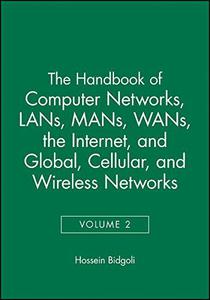 Handbook of Computer Networks: LANs, MANs, WANs, the Internet, and Global, Cellular, and Wireless Networks, Volume 2 By 2008 | 1276 Pages | ISBN: 0471784591 | PDF | 27 MB Volume II: LANs, MANs, WANs, The Internet, and Global, Cellular, and Wireless Networks.Part 1: LANs, MANs, and WANs. Local Area Networks (Wayne C. Summers). Ethernet LANs (William Stallings). Token Ring LANs (Norman C. Strole, Werner Bux, and Robert D. Love). Optical Fiber LANs (Mo Adda, Amanda Peart, and Jau Ming Chew). Windows 2000 Operating System (Dario Forte). Linux Operating System (Mark Shacklette). Metropolitan Area Networks (Richard J. Nieporent). Terrestrial Wide Area Networks (Gurdeep Singh Hura). Packet Switching (Qinqing Zhang and Qi Bi). Circuit Switching (Farid Farahmand and Qiong (Jo) Zhang). Message Switching (Farid Farahmand). Frame Relay (Eddie Rabinovitch). Asynchronous Transfer Mode (ATM) (Arjan Durresi and Raj Jain). Broadband Integrated Services Digital Network (B. Muthukumaran). DSL (Digital Subscriber Line) (Milos Milosevic). Cable Modems (Shaheed N. Mohammed). Home Networking (Sherali Zeadally). Multimedia Networking (Hans-Peter Dommel).Part 2: The Internet, Global Networks, and VoIP. The Internet Fundamentals (Hossein Bidgoli). History of the Internet (John Lucas Sherry and Nicholas David Bowman). Internet2 (Linda Bruenjes and Carolyn Siccama). Internet Domain Name System (Krishna Jayakar). Information Retrieval on the Internet (Raymond F. Wisman). Internet Architecture (Geoffrey G. Xie). TCP/IP Suite (Prabhaker Mateti). SMTP (Simple Mail Transfer Protocol) (Vladimir V. Riabov). IP Multicast (Emilia Rosti). Network QoS (Ying Lu). Internet Security Standards (Raymond R. Panko). Technology and Standards for Low-Bit-Rate Vocoding Methods (Miguel Arjona Ramirez and Mario Minami). Voice Over Internet Protocol (Sherali Zeadally and Farhan Siddiqui). Signaling Approaches (Edmundo Monteiro, Fernando Boavida, Marilia Curado, and Luis Cordeiro). Voice over MPLS and VoIP over MPLS (Junaid Ahmed Zubairi). Telephone Number Mapping (ENUM) (Leslie L. Daigle). Web Hosting (Thomas C. Bressoud). End-System QoS (Tarek F. Abdelzhaer and Chengdu Huang). Web Services (Mei-Ling L. Liu).Part 3: Cellular and Wireless Networks. Cellular Communications Channels (Aarne Mammela and Risto Wichman). Cellular Telephony (Elyes Ben Ali Bdira). Mobile Radio Communications (Chi Zhou). Evolution of Mobile Cellular Networks (Jiang Xie and Xiaoyuan Gu). Global System for Mobile Communications (Mohamed A. Haleem and Koduvayur P. Subbalakshmi). General Packet Radio Service (Allen H. Levesque). Location Management in Personal Communication Systems (Jingyuan Zhang and Ivan Stojmenovic). Mobility Management in Heterogeneous Networks (Guangbin Fan, Xuming Lu, and Song Ci). Universal Mobile Telecommunications System (Faouzi Zarai, Noureddine Boudriga, and Mohammad S. Obaidat). International Mobile Telecommunications-2000 and 3G Wireless Systems (Mustafa M. Matalgah and Omar M. Hammouri). Code Division Multiple Access (CDMA) (Frank H.P. Fitzek and Marcos Katz). Time-Division Multiple Access (Tom S. Chan). Carrier Sense Multiple Access Protocols (Wei Ye). Bluetooth Technology (Brent A. Miller). Satellite Communications Basics (Michele Luglio and Antonio Saitto). Land-Mobile Satellite Channel (Emilio Matricciani). Geosynchronous Fixed Satellite Communications (Michele Luglio and Antonio Saitto). Satellites in IP Networks (Fatih Alagoz and Abbas Jamalipour). Global Navigation Satellite Systems (Omar Al-Bayari and Balqies Sadoun). Wireless LANs (Mohammad S. Obaidat, G. I. Papadimitriou, and S. Obeidat). Wireless LAN Standards (Prashant Krishnamurthy). Bit-Interleaved Coded Modulation (Yuheng Huang and James A. Ritcey). The Wireless Application Protocol (Lillian N. Cassel and Arun Srinivasa Murthy). Wireless ATM (Amel Meddeb and Noureddine Boudriga). Wireless IP Telephony (Manish Marwah and Shivakant Mishra). Wireless Internet (Abbas Jamalipour). Internetworking of Heterogeneous Wireless Networks (Sherali Zeadally and Farhan Siddiqui). Principles and Applications of Ad Hoc and Sensor Networks (Marco Conti). Medium Access in Ad Hoc and Sensor Networks (Vojislav B. Misic and Jelena Misic). Emerging Trends in Routing Protocols in Mobile Wireless Ad Hoc and Sensor Networks (Jamal N. Al-Karaki). Broadcasting in Ad Hoc and Sensor Networks (Francois Ingelrest, David SimDescription-Ryl, Hong Guo, and Ivan Stojmenovic). Data Monitoring and Gathering in Sensor Networks (Symeon Papavassiliou, Stella Kafetzoglou, and Jin Zhu). In-Network Data Aggregation in Wireless Sensor Networks (Kemal Akkaya and Ismail Ari). Cognitive and Software Defined Radios for Dynamic Spectrum Access (Troy Weingart and Douglas C. Sicker). Localization in Wireless Networks (Slim Rekhis, Noureddine Boudriga, and Mohammad S. Obaidat). Interference Management in Wireless Networks (Keivan Navaie and Shahrokh Valaee). Wireless Wide Area Networks (Anthony H. Smith and Raymond A. Hansen). Wireless Broadband Access (Hsiao-Hwa Chen and Mohsen Guizani). Indoor Wireless Infrared Communications (Z. Ghassemlooy).Content: Chapter 1 Local Are Network (pages 1-18): Wayne C. SummersChapter 2 Etherent LANs (pages 19-26): William StallingsChapter 3 Token Ring LANs (pages 27-39): Norman C. Strole, Werner Bux and Robert D. LoveChapter 4 Oftical Fiber LANs (pages 40-56): Mo Adda, Amanda Peart and Jau Ming ChewChapter 5 Windows 2000 Operating System (pages 57-77): Dario ForteChapter 6 Linux Operating System (pages 78-90): Mark ShackletteChapter 7 Metropolitan Area Networks (pages 91-115): Richard J. NieporentChapter 8 Terrestrial Wide Area Networks (pages 116-135): Gurdeep Singh HuraChapter 9 Packet Switching (pages 136-145): Qinqing Zhang and Qi BiChapter 10 Circuit Switching (pages 146-158): Farid Farahmand and Qiong (Jo) ZhangChapter 11 Message Switching (pages 159-171): Farid FarahmandChapter 12 Frame Relay (pages 172-182): Eddie RabinovitchChapter 13 Asynchronous Trasfer Mode (ATM) (pages 183-199): Arjan Durresi and Raj JainChapter 14 Broadband Integrated Services Digital Network (pages 200-209): B. MuthukumaranChapter 15 DSL (Digital Subscriber Line) (pages 210-220): Milos MilosevicChapter 16 Cable Modems (pages 221-229): Shaheed N. MohammedChapter 17 Home Networking (pages 230-245): Sherali ZeadallyChapter 18 Multimeadia Networking (pages 246-263): Hans?Peter DommelChapter 19 The Internet Fundamentals (pages 265-279): Hossein BidgoliChapter 20 History of the Internet (pages 280-293): John Lucas Sherry and Nicholas David BowmanChapter 21 Internet2® (pages 294-304): Linda BruenjesChapter 22 Internet Domain Name System (pages 305-319): Krishna JayakarChapter 23 Information Retrieval on the Internet (pages 320-344): Raymond F. WismanChapter 24 Internet Architecture (pages 345-357): Geoffrey G. XieChapter 25 TCP/IP Suite (pages 358-387): Prabhaker MatetiChapter 26 SMTP (Simple Mail Transfer Protocol) (pages 388-406): Vladimir V. RiabovChapter 27 IP Multicast (pages 407-416): Emilia RostiChapter 28 Network QoS (pages 417-427): Ying LuChapter 29 Internet Security Standards (pages 428-446): Raymond R. PankoChapter 30 Technology and Standards for Low?Bit?Rate Vocoding Methods (pages 447-467): Miguel Arjona Ramirez and Mario MinamiChapter 31 Voice Over Internet Protocol (pages 468-487): Sherali Zeadally and Farhan SiddiquiChapter 32 Signaling Approaches (pages 488-508): Edmundo Monteiro, Fernando Boavida, Marilia Curado and Luis CordeiroChapter 33 Voice over MPLS and VoIP over MPLS (pages 509-518): Junaid Ahmed ZubairiChapter 34 Telephone Number Mapping (ENUM) (pages 519-531): Leslie L. DaigleChapter 35 Web Hosting (pages 532-544): Thomas C. BressoudChapter 36 End?System QoS (pages 545-558): Tarek F. Abdelzhaer and Chengdu HuangChapter 37 Web Services (pages 559-575): Mei?Ling L. LiuChapter 38 Cellular Communications Channels (pages 577-590): Aarne Mammela and Risto WichmanChapter 39 Cellular Telephony (pages 591-615): Elyes Ben Ali BdiraChapter 40 Mobile Radio Communications (pages 616-629): Chi ZhouChapter 41 Evolution of Mobile Cellular Netoworks (pages 630-641): Jiang Xie and Xiaoyuan GuChapter 42 Global System for Mobile Communications (pages 642-657): Mohamed A. Haleem and Koduvayur P. SubbalakshmiChapter 43 General Packet Radio Service (pages 658-674): Allen H. LevesqueChapter 44 Location Management in Personal Communication Systems (pages 675-684): Jingyuan Zhang and Ivan StojmenovicChapter 45 Mobility Management in Heterogeneous Networks (pages 685-698): Guangbin Fan, Xuming Lu and Song CiChapter 46 Universal Mobile Telecommunications System (pages 699-715): Faouzi Zarai, Noureddine Boudriga and Mohammad S. ObaidatChapter 47 International Mobile Telecommunications?2000 and 3G Wireless Systems (pages 716-750): Mustafa M. Matalgah and Omar M. HammouriChapter 48 Code Division Multiple Access (CDMA) (pages 751-768): Frank H. P. Fitzek and Marcos KatzChapter 49 Time?Division Multiple Access (pages 769-778): Tom S. ChanChapter 50 Carrier Sense Multiple Access Protocols (pages 779-789): Wei YeChapter 51 Bluetooth Technology (pages 790-801): Brent A. MillerChapter 52 Satellite Communications Basics (pages 802-814): Michele Luglio and Antonio SaittoChapter 53 Land?Mobile Satellite Channel (pages 815-835): Emilio MatriccianiChapter 54 Geosynchronous Fixed Satellite Communications (pages 836-859): Michele Luglio and Antonio SaittoChapter 55 Satellites in IP Networks (pages 860-876): Fatih Alagoz and Abbas JamalipourChapter 56 Global Navigation Satellite Systems (pages 877-895): Omar Al?Bayari and Balqies SadounChapter 57 Wireless LANs (pages 896-916): M.S. Obaidat, G. I. Papadimitriou and S. ObeidatChapter 58 Wireless LAN Standards (pages 917-934): Prashant KrishnamurthyChapter 59 Bit?Interleaved Coded Modulation (pages 935-954): Yuheng Huang and James A. RitceyChapter 60 The Wireless Application Protocol (pages 955-971): Lillian N. Cassel and Arun Srinivasa MurthyChapter 61 Wireless ATM (pages 972-990): Amel Meddeb and Noureddine BoudrigaChapter 62 Wireless IP Telephony (pages 991-999): Manish Marwah and Shivakant MishraChapter 63 Wireless Internet (pages 1000-1017): Abbas JamalipourChapter 64 Internetworking of Heterogeneous Wireless Networks (pages 1018-1039): S. Zeadally and F. SiddiquiChapter 65 Principles and Applications of Ad Hoc and Sensor Networks (pages 1040-1056): Marco ContiChapter 66 Medium Access in Ad Hoc and Sensor Networks (pages 1057-1083): Vojislav B. Misic and Jelena MisicChapter 67 Emerging Trends in Routing Protocols in Mobile Wireless Ad Hoc and Sensor Networks (pages 1084-1100): Jamal N. Al?KarakiChapter 68 Broadcasting in Ad Hoc and Sensor Networks (pages 1101-1112): Francois Ingelrest, David SimDescription?Ryl, Hong Guo and Ivan StojmenovicChapter 69 Data Monitoring and Gathering in Sensor Networks (pages 1113-1130): Symeon Papavassiliou, Stella Kafetzoglou and Jin ZhuChapter 70 In?Network Data Aggregation in Wireless Sensor Networks (pages 1131-1146): Kemal Akkaya and Ismail AriChapter 71 Cognitive and Software Defined Radios for Dynamic Spectrum Access (pages 1147-1157): Troy Weingart and Douglas C. SickerChapter 72 Localization in Wireless Networks (pages 1158-1177): Slim Rekhis, Noureddine Boudriga and Mohammad S. ObaidatChapter 73 Interference Management in Wireless Networks (pages 1178-1190): Keivan Navaie and Shahrokh ValaeeChapter 74 Wireless Wide Area Networks (pages 1191-1199): Anthony H. Smith and Raymond A. HansenChapter 75 Wireless Broadband Access (pages 1200-1222): Hsiao?Hwa Chen and Mohsen GuizaniChapter 76 Indoor Wireless Infrared Communications (pages 1223-1236): Z. Ghassemlooy
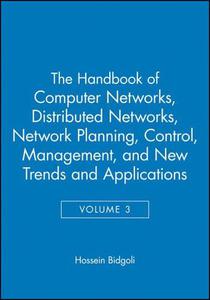 Handbook of Computer Networks: Distributed Networks, Network Planning, Control, Management, and New Trends and Applications, Volume 3 By 2008 | 1115 Pages | ISBN: 0471784605 | PDF | 32 MB Volume III: Distributed Networks, Network Planning, Control, Management, and New Trends and Applications.Part 1: Distributed Networks. Client/Server Computing Basics (Daniel McFarland and Darren B. Nicholson). Groupware (Robert Slagter). Network Middleware (Linda Volonino and Pragati Dalal). Grid Computing Fundamentals (Mark Baker). Grid Computing Implementation (Barry Wilkinson and Clayton Ferner). Cluster Computing Fundamentals (Hong Ong and Mark Baker). Next-Generation Cluster Networks (Keren Bergman, Benjamin A. Small, and Larry A. Bergman). Utility Computing on Global Grids (Chee Shin Yeo, Rajkumar Buyya, Marcos Dias de Assuncao, Jia Yu, Anthony Sulistio, Srikumar Venugopal and Martin Placek). Peer-to-Peer Network Architecture (Jing Wu and Michel Savoie). Peer-to-Peer Network Applications (Stan Kurkovsky). Incentive Issues in Peer-to-Peer Systems (Yu-Kwong Kwok). Storage Area Network Fundamentals (Vladimir V. Riabov). Fiber Channel (Jiying Zhao). Storage Area Networks: Architectures and Protocols (Nirwan Ansari and Si Yin). Distributed Intelligent Networks (G. N. Prezerakos and I. S. Venieris). Smart Cards: Communication Protocols and Applications (Michael Tunstall, Konstantinos Markantonakis, Damien Sauveron, and Keith Mayes). Fault-Tolerant Systems (Amiya Nayak). Distributed Algorithms (Valmir C. Barbosa). Distributed Databases (David Coquil and Harald Kosch).Part 2: Network Planning, Control, and Management. Network Capacity Planning (Priscilla Oppenheimer). Network Traffic Modeling (Thomas M. Chen). Network Traffi c Management (Thomas M. Chen). Network Security Risk Assessment and Management (Dan Port, Rick Kazman, and David Klappholz). Network Reliability and Fault Tolerance (Matthew Liotine). Social Engineering (Benjamin Bock, Markus D. Klemen, and Edgar R. Weippl). Intrusion-Detection Systems (Peng Ning and Sushil Jajodia). Network Attacks (Mohamed Hamdi and Noureddine Boudriga). Computer Viruses and Worms (Robert Slade). Denial of Service Attacks (Qijun Gu and Peng Liu). E-Mail Threats and Vulnerabilities (David Harley). Virtual Private Networks (G. I. Papadimitriou, M. S. Obaidat, C. Papazoglou, and A.S.Pomportsis). Cryptography (Ari Juels) Access Control (Sabrina De Capitani di Vimercati, Sara Foresti,Stefano Paraboschi, and Pierangela Samarati) Biometrics (James L. Wayman). Firewalls (James E. Goldman). Authentication (Patrick McDaniel). Password Authentication (Jeremy L. Rasmussen). Physical Security Threats and Measures (Mark Michael). Computer Security Incident Response Teams (CSIRTs) (Raymond R. Panko). Backup and Recovery System Requirements (David R. Reavis). Business Requirements of Backup Systems (Markus Klemen, Thomas Neubauer, and Edgar R. Weippl). Evaluating Storage Media Requirements (David R. Reavis). Business Continuity Planning (Marco Cremonini and Pierangela Samarati). E-Mail and Internet Use Policies (Nancy J. King). Computer Network Management (Jian Ren).Part 3: Computer Network Popular Applications and Future Directions. E-mail and Instant Messaging (Bhagyavati). Application Service Providers (ASPs) (Bandula Jayatilaka). Videoconferencing (Ketan Mayer-Patel). Computer Conferencing: Protocols and Applications (William R. Gillis and Colleen Taugher). Telecommuting and Telework (Michael Workman). Online Banking (Ronnie J. Phillips). Digital Libraries (Cavan McCarthy). Computer Conferencing and Distance Learning (Liam Rourke and Heather Kanuka). Electronic Commerce (Charles Steinfield). Electronic Data Interchange (EDI) (Matthew K. McGowan). Electronic Payment Systems (Indrajit Ray). Internet Relay Chat (IRC) (James M. Hudson and Paul L. Witt). Online Communities (Lee Sproull and Manuel Arriaga). Mobile Commerce (Vijay Atluri). Online News (Bruce Garrison and Marcus Messner). Travel and Tourism (Ulrike Gretzel, Youcheng Wang, and Daniel R. Fesenmaier). Web-Based Training (Patrick J. Fahy). RFID (Radio-Frequency Identification) (Stephen A. Weis). Active Networking (Stephen F. Bush). Applications of Biological Concepts to Designs of Computer Networks and Network Applications (Tatsuya Suda, Tadashi Nakano, and Keita Fujii). Nanotechnology for Communication Systems (Syed H. Murshid and Azhar M. Khayrattee). Molecular Communication: New Paradigm for Communication among Nanoscale Biological Machines (Michael Moore, Akihiro Enomoto, Tatsuya Suda, Tadashi Nakano, and Yutaka Okaie).Content: 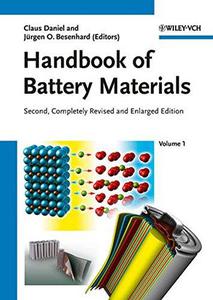 Handbook of Battery Materials, Second Edition By 2011 | 1007 Pages | ISBN: 3527326952 | PDF | 29 MB A one-stop resource for both researchers and development engineers, this comprehensive handbook serves as a daily reference, replacing heaps of individual papers. This second edition features twenty percent more content with new chapters on battery characterization, process technology, failure mechanisms and method development, plus updated information on classic batteries as well as entirely new results on advanced approaches. The authors, from such leading institutions as the US National Labs and from companies such as Panasonic and Sanyo, present a balanced view on battery research and large-scale applications. They follow a distinctly materials-oriented route through the entire field of battery research, thus allowing readers to quickly find the information on the particular materials system relevant to their research.  Handbook of Applied Cognition, Second Edition By 2007 | 892 Pages | ISBN: 0470015349 | PDF | 10 MB Written by a team of leading international researchers under the guidance of Frank Durso, the second edition of the Handbook of Applied Cognition brings together the latest research into this challenging and important field, and is presented across thirty stimulating and accessible chapters. Stewarded by experiences editors from around the globe, the handbook has been fully updated with eleven new chapters covering materials that focus on the topics critical to understanding human mental functions in complex environments. It is an essential single-source reference for researchers, cognitive engineers and applied cognitive psychologists, as well as advanced students in the flourishing field of applied cognition.Content: Chapter 1 Applied Cognitive Psychology in the Context of Everyday Living (pages 1-27): Wendy A. Rogers, Richard Pak and Arthur D. FiskChapter 2 Attention (pages 29-54): David L. Strayer and Frank A. DrewsChapter 3 Working Memory (pages 55-82): Aysecan Boduroglu, Meredith Minear and Priti ShahChapter 4 Knowledge and Expertise (pages 83-109): Stephan Lewandowsky, Daniel Little and Michael L. KalishChapter 5 Episodic Memory (pages 111-136): Scott D. Gronlund, Curt A. Carlson and Debra TowerChapter 6 Metamemory (pages 137-161): John Dunlosky, Michael J. Serra and Julie M. C. BakerChapter 7 Comprehension and Situation Awareness (pages 163-193): Francis T. Durso, Katherine A. Rawson and Sara GirottoChapter 8 Decision?Making (pages 195-217): Winston R. Sieck and Gary KleinChapter 9 Human Error: Trick or Treat? (pages 219-238): Erik HollnagelChapter 10 Team Cognition (pages 239-268): Nancy J. Cooke, Jamie C. Gorman and Jennifer L. WinnerChapter 11 Industrial Systems (pages 269-305): Neville MorayChapter 12 Patient Safety in Health Care (pages 307-331): Vimla L. Patel and Jiajie ZhangChapter 13 Skill in Sport (pages 333-359): Bruce Abernethy, Jonathan P. Maxwell, Robin C. Jackson and Richard S. W. MastersChapter 14 Aviation (pages 361-389): Christopher WickensChapter 15 Driving (pages 391-414): Geoffrey Underwood, David Crundall and Peter ChapmanChapter 16 Automated and Interactive Real?Time Systems (pages 415-441): Bernd Lorenz and Raja ParasuramanChapter 17 Cognitive Models of Human-Information Interaction (pages 443-470): Peter PirolliChapter 18 Personal Information Management (pages 471-495): William Jones and Brian H. RossChapter 19 Computer?Supported Cooperative Work (pages 497-526): Gary M. Olson and Judith S. OlsonChapter 20 Online Courses (pages 527-552): Ruth H. Maki and William S. MakiChapter 21 Instruction (pages 553-583): Lindsey E. Richland, Marcia C. Linn and Robert A. BjorkChapter 22 Cognitive Rehabilitation (pages 585-604): Barbara A. WilsonChapter 23 Personnel Selection and Testing (pages 605-627): Margaret E. Beier and Phillip L. AckermanChapter 24 Mental Illness and Mental Health (pages 629-658): Megan E. Hughes, Catherine Panzarella, Lauren B. Alloy and Lyn Y. AbramsonChapter 25 Media (pages 659-682): Richard Jackson Harris, Elizabeth T. Cady and Christopher P. BarlettChapter 26 Consumer Psychology (pages 683-711): Joseph W. Alba and J. Wesley HutchinsonChapter 27 Protection of the Environment (pages 713-738): Raymond S. NickersonChapter 28 Juror Decision?Making (pages 739-761): Ryan J. Winter and Edith GreeneChapter 29 Eyewitness Testimony (pages 763-786): Daniel B. Wright and Graham M. DaviesChapter 30 False Memories (pages 787-812): Giuliana Mazzoni and Alan Scoboria
 Hamatologie: Theorie und Praxis fur medizinische Assistenzberufe, Zweite Auflage By Dr. Rolf Mahlberg, Annette Gilles, Anita Lasch(auth.) 2005 | 311 Pages | ISBN: 3527311858 | PDF | 17 MB Seit dem Erscheinen der ersten Auflage 1994 ist das Lehrbuch "H?tologie" nicht mehr zu stoppen. Die vorliegende neue, stark berarbeitete und aktualisierte Auflage integriert den neuesten Stand der MTA-Ausbildung. Das Buch orientiert sich thematisch am Lehrinhaltskatalog des Deutschen Verbands Technischer Assistentinnen und Assistenten in der Medizin (dvta). Didaktisch ausgeklgelt ist der Band eine unerl?liche Hilfe in der Ausbildung. Drei Jahre dauert die Ausbildung zur/zum MTA. Es sind drei lernintensive Jahre mit einem anspruchsvollen Mix aus Theorie und Praxis. "H?tologie" ist das bew?te Lehrbuch, das nun schon einige Generationen von MTA-Auszubildenden begleitet hat. Das Buch gliedert sich in einen theoretischen und einen praktischen Teil. Ersterer behandelt die Grundlagen der H?tologie und ihrer Krankheitsbilder. Der praktische Teil vermittelt die in der h?tologischen Diagnostik und Therapie verwendeten Techniken. Es gibt zahlreiche Handlungsanleitungen fr die t?iche Arbeit. Daneben wird kompetent in Physiologie, Pathophysiologie und Labordiagnostik eingefhrt. Der bersichtliche Aufbau sowie etliche erl?ernde Tabellen und Abbildungen erleichtern das Verst?nis. Und die berzeugende Stoffvermittlung macht vor allem eines deutlich: Die Autoren bringen jahrelange Erfahrung aus der MTA-Ausbildung mit. Dabei tr? die neue Auflage den umfangreichen Fortschritten Rechnung, die insbesondere in der molekularbiologischen Diagnostik erreicht wurden.  Get Slim Arms and Toned Back and Shoulders in 7 Days At Home- Complete, Fast and Easy Upper Body Workout 4 Mins a day (No Equipment needed) by Workout Minimalistic English | 2022 | ISBN: N/A | ASIN: B09RPYJV6V | 60 pages | EPUB | 2.13 Mb Get Slim Arms and Toned Back and Shoulders in 7 Days At Home- Complete, Fast and Easy Upper Body Workout 4 Mins a day (No Equipment needed) |